From Campus to Community: ABE-LINC’s Model for Digital Navigation
The ABE-LINC Project is Bringing Digital Navigators and Broadband Infrastructure To Chicago State University’s Southside Campus and Beyond
Part of the Broadband READY Stories Series
Northeast Region | Chicago State University
By: Robbie McBeath, Illinois Broadband Lab
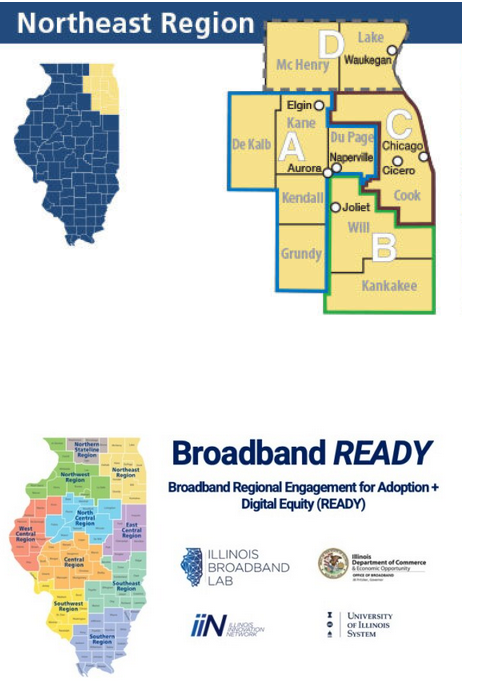 In a city celebrated for its vibrant neighborhoods, many on Chicago’s South Side tell
a more sobering story—one of digital exclusion and systemic disinvestment. While broadband
access is often taken for granted in many parts of the city, communities like Roseland,
home to Chicago State University (CSU), continue to face significant barriers to connectivity. With nearly 12% of
Roseland households lacking computing devices and over 16% relying solely on smartphones, the digital divide is not just a technological
issue—it’s a matter of access, opportunity, and justice.
In a city celebrated for its vibrant neighborhoods, many on Chicago’s South Side tell
a more sobering story—one of digital exclusion and systemic disinvestment. While broadband
access is often taken for granted in many parts of the city, communities like Roseland,
home to Chicago State University (CSU), continue to face significant barriers to connectivity. With nearly 12% of
Roseland households lacking computing devices and over 16% relying solely on smartphones, the digital divide is not just a technological
issue—it’s a matter of access, opportunity, and justice.
In today’s digital economy, digital literacy is the foundation for participation in emerging sectors like artificial intelligence (AI), quantum computing, and advanced data analytics. These technologies are not only reshaping global markets but also defining national competitiveness. The United States is a leader in the world in quantum research and AI innovation, yet without equitable access to broadband and digital skills, entire communities risk being left behind in this transformation. Bridging this gap is essential to ensure that every individual can contribute to and benefit from the opportunities of the 21st-century economy.
Recognizing this urgent need in neighborhoods across the city, CSU, Northeastern Illinois University (NEIU), and the University of Illinois Chicago (UIC) collaborated to launch the ABE-LINC initiative - Advancing Broadband Equity through Learning Intermediaries in the Neighborhoods of Chicago. In partnership with several key organizations like the Illinois Innovation Network and supported by a federal Connecting Minority Communities grant, CSU & NEIU are deploying digital navigators—trained community members and students who provide hands-on digital literacy training, device distribution, and affordable broadband connectivity to residents. These individuals often university students—serve as guides, mentors, and problem-solvers. They help people get online, learn how to use devices, and access essential services like healthcare, education, and employment. These efforts are not only transforming individual lives but also reshaping the digital landscape of entire neighborhoods.
Through ABE-LINC and augmented by the Illinois Broadband Lab’s Broadband READY program - a program which helps universities scale innovative approaches toward expanding broadband access, adoption, and use—CSU is proving that universities can be engines of community empowerment. By combining broadband infrastructure upgrades with grassroots engagement, CSU is bridging the gap between technology and the people who need it most. This is more than a story about internet access—it’s about building a more inclusive future, one connection at a time.
What Makes ABE-LINC Unique?
 ABE-LINC is a collaborative program led by CSU, NEIU, and UIC with support from the
Illinois Innovation Network (IIN) and several other key local and regional partners.
The program’s mission is to help people in specific underserved neighborhoods gain
access to broadband and the skills to use it effectively.
ABE-LINC is a collaborative program led by CSU, NEIU, and UIC with support from the
Illinois Innovation Network (IIN) and several other key local and regional partners.
The program’s mission is to help people in specific underserved neighborhoods gain
access to broadband and the skills to use it effectively.
These university partners organized to apply for a Connecting Minority Communities (CMC) Program grant, from the U.S. Department of Commerce’s National Telecommunications and Information Administration (NTIA). The CMC Program received more than 200 applications, resulting in more than $833 million in funding requests. In early 2023, the ABE-LINC project was awarded $3.25 million in funding and launched its pilot program in May of that year.
What makes ABE-LINC unique? In short, Minority Serving Institutions leading the development of homegrown connections—both with navigators and internet access.
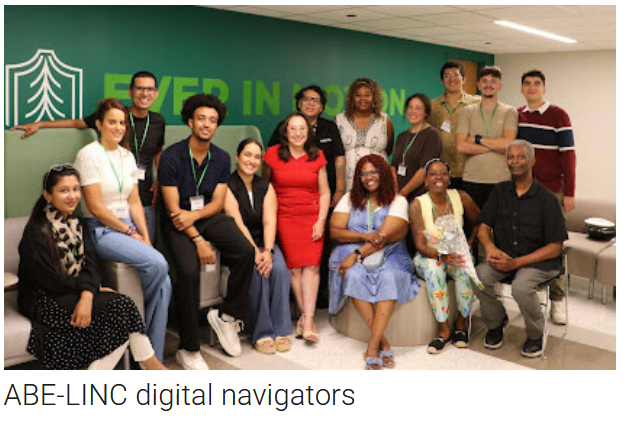 Digital Navigators: Together, CSU and NEIU run the Digital Navigator program which provides training on
basic digital literacy, digital conduct, online resources and tools, and internet
subscriptions and device purchases. The navigators receive digital skills and workforce
development trainings themselves and come from and serve specific zip codes and populations,
including returning citizens, seasonal transitory and undocumented workers, and single-parent
households. The navigators also provide laptops to households of priority neighborhoods
to fill gaps in the ability to access telehealth resources and educational and employment
opportunities.
Digital Navigators: Together, CSU and NEIU run the Digital Navigator program which provides training on
basic digital literacy, digital conduct, online resources and tools, and internet
subscriptions and device purchases. The navigators receive digital skills and workforce
development trainings themselves and come from and serve specific zip codes and populations,
including returning citizens, seasonal transitory and undocumented workers, and single-parent
households. The navigators also provide laptops to households of priority neighborhoods
to fill gaps in the ability to access telehealth resources and educational and employment
opportunities.
Improving Fiber Infrastructure: The grant also supported building and improving broadband capacity at CSU by connecting the institution’s fiber-optic network to the statewide fiber-optic network Illinois Century Network (ICN). Until recently, a main line of the ICN fiber network ran 2 blocks away from CSU’s campus, but it was never connected. Through ABE-LINC, fiber installation completed in July 2024, connecting CSU to the ICN and at a reliable 10 gigabits per second (Gbps) speed connection. With further funding and network upgrades, CSU hopes to increase to 40 Gbps speed.
Direct Community Involvement: A goal of NTIA’s CMC program is to be geographically targeted. The ABE-LINC program was aimed to tackle the digital divide within eligible census tracts within the 15-mile radius of CSU and NEIU. Digital navigators are placed by local organizations throughout the neighborhoods near campuses. NEIU connects with organizations that go as far as Chicago’s Northwest Side to the Lower West Side, including neighborhoods such as Heart of Chicago, Pilsen, and Little Village. CSU focuses on the city’s South Side and South suburbs. Partnering with local organizations ensures digital navigators are of and for their communities and provides the framework for these partnerships to continue services beyond the scope of the grant.
How ABE-LINC’s Digital Navigators Improve Lives
The ABE-LINC CMC grant enabled CSU & NEIU to recruit seven full-time digital navigators, who provide trainings at three specific sites each.
Digital navigators work directly with members of the neighborhood community, offering six to eight week digital literacy courses at these partner sites on topics such as: Basic digital literacy (how to use devices and apps); Online safety and privacy; Access to online tools for education, jobs, and healthcare; Help with internet plans and devices, and more.
Programs began in Spring 2024, and Digital navigators will run their fifth and final cohort in Fall 2025, if funding is not extended.
Through Summer 2025, ABE-LINC digital navigators at CSU and NEIU have:
- Engaged 989 participants in digital skills training cohorts
- Conducted 3,384 hours of digital literacy training
- Connected 176 Illinoisans to affordable broadband internet through partnerships with Compudot
- Distributed 821 total devices like affordable laptops
The work of ABE-LINC is ongoing, with more impact data expected when the project is professionally evaluated. And the success of ABE-LINC and Broadband READY isn’t just measured in data—it’s seen in the lives changed. From helping a grandmother learn to navigate telehealth appointments to guiding a job seeker through online applications, CSU’s digital navigators are making technology more accessible and less intimidating.
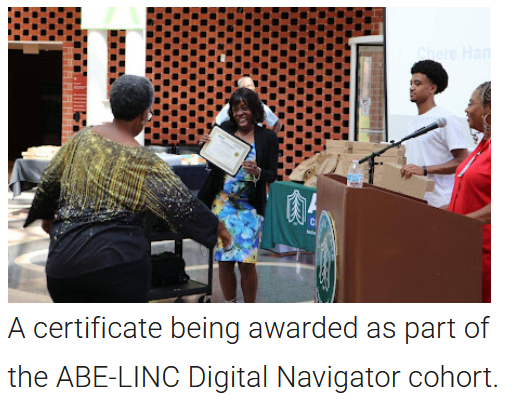 “The ABE-LINC project has had many cohorts of digital learners and it has been rewarding
seeing participants from different age groups overcome their fears by engaging in
digital learning,” said ABE-LINC Project Manager Nathalia Cardenas. “We had a 92-year-old
participant that learned how to use a computer and said she finally felt connected
to this new world. It is important to remind individuals that it is never to late
to learn a new skill.”
“The ABE-LINC project has had many cohorts of digital learners and it has been rewarding
seeing participants from different age groups overcome their fears by engaging in
digital learning,” said ABE-LINC Project Manager Nathalia Cardenas. “We had a 92-year-old
participant that learned how to use a computer and said she finally felt connected
to this new world. It is important to remind individuals that it is never to late
to learn a new skill.”
Increasing digital skills can also increase economic development. ABE-LINC collaborated with the Foundation of Little Village (FLV) and helped small business owners learn how to promote their services online, manage digital storefronts, and use social media effectively. FLV focuses on business education, financial literacy training, one-on-one technical support, networking opportunities, and business financial resources such as in house micro-grants. In spring 2025, Digital Navigators held an expo for local small business leaders to connect with community members. With the buzz and activity akin to a farmers’ market, community members could learn about and buy products through the Square digital purchasing platform, a capacity these business owners now possessed because of ABE-LINC.
When Universities Collaborate, Communities Win
The ABE-LINC grant is ultimately embedded with three universities: Chicago State University (CSU), Northeaster Illinois University (NEIU), and the University of Illinois at Chicago (UIC). But the successful grant showcases how the Illinois Innovation Network (IIN), a system of connected university-community-industry-based hubs throughout the state, does what it does best: facilitate collaboration. IIN invited collaborators and guided development of the project proposal, bringing together several local partners including Northern Illinois University, the Illinois Innovation Network, and local grant partners including Governors State University, Chicago Urban League, City Colleges of Chicago, Illinois Department of Innovation and Technology, Instituto del Progreso Latino, Chicago Commons, Cook County Sheriff’s Department, PCs for People, and Safer Foundation.
Universities have a special role to play to bring digital inclusion beyond campuses and into their wider communities. As in the case with CSU, universities bring something unique to the table: trusted community presence, student talent and energy, access to research and resources, and a long-term commitment to public service.
ABE-LINC digital navigators are a perfect example. These students are not just gaining work experience—they’re building relationships, solving real problems, and becoming leaders in their communities. Part of their training to become digital navigators include social emotional learning and skills to work with a variety of different cultures, as well as general workforce development.
Pamesha Robinson was trained to be a Digital Navigator through ABE-LINC, which allowed her to become connected with the scores of local organizations in the ABE-LINC footprint and eventually secure full-time employment. “Being a digital navigator prepared me for my job opportunity,” Pamesha said.
Enrollment at CSU has also seen benefits from ABE-LINC. Grant manager and CSU Professor Dr. Daniel Block has seen several family members of cohorts move on to become CSU students. On two occasions, Dr. Block himself has walked family members to the CSU enrollment office.
Increased Impact Through Broadband READY
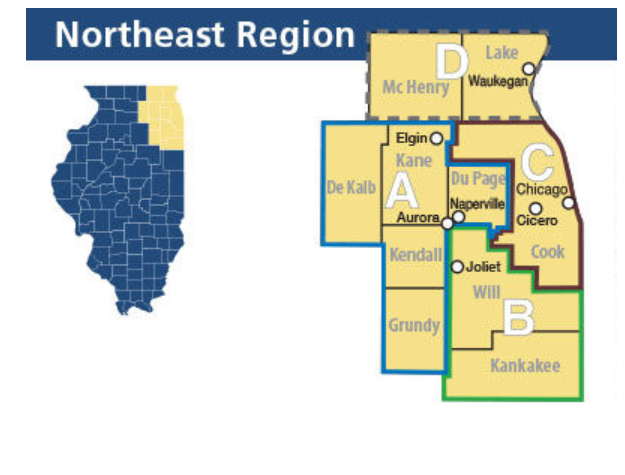 While ABE-LINC focuses on direct engagement in Chicago, the Broadband READY program
helps expand the mission across the Northeast region (Cook, DeKalb, DuPage, Grundy,
Kane, Kankakee, Kendall, Lake, Mc Henry, and Will Counties). Led by the Illinois Broadband
Lab, Broadband READY empowers universities across Illinois’ 10 economic regions to
serve as regional hubs for broadband planning and direct digital inclusion projects.
Originally stemming from Governor J.B. Pritzker’s 2019 Connect Illinois initiative,
funding is provided to higher education institutions and qualified regional entities
statewide to explore opportunities for equitable advances in the areas of broadband
access, adoption, and utilization.
While ABE-LINC focuses on direct engagement in Chicago, the Broadband READY program
helps expand the mission across the Northeast region (Cook, DeKalb, DuPage, Grundy,
Kane, Kankakee, Kendall, Lake, Mc Henry, and Will Counties). Led by the Illinois Broadband
Lab, Broadband READY empowers universities across Illinois’ 10 economic regions to
serve as regional hubs for broadband planning and direct digital inclusion projects.
Originally stemming from Governor J.B. Pritzker’s 2019 Connect Illinois initiative,
funding is provided to higher education institutions and qualified regional entities
statewide to explore opportunities for equitable advances in the areas of broadband
access, adoption, and utilization.
Each participating READY university:
- Leads a digital inclusion impact project in their region
- Hosts regional convenings to bring stakeholders together
- Helps facilitate community outreach and connections with the Illinois Broadband Lab and Illinois Office of Broadband to ensure Illinois’ digital ecosystems stretch statewide
The READY program allows higher education institution within the Illinois Innovation Network to be active hubs for digital engagement within their communities and regions at large.
By connecting Broadband READY with ABE-LINC, CSU and NEIU were able to augment funding to facilitate convenings and trainings beyond the 15-mile radius of the CMC grant, expand the digital literacy training opportunities, and increase the number of devices distributed to the community.
Chicago State University plays a key role as the Northeast region READY Hub, helping to coordinate efforts across the city and suburbs. This regional leadership enables CSU and the Northeast READY team to connect with nonprofits, city and county agencies, and other leading institutions also doing incredible work to increase digital inclusion, contributing to an active digital equity ecosystem.
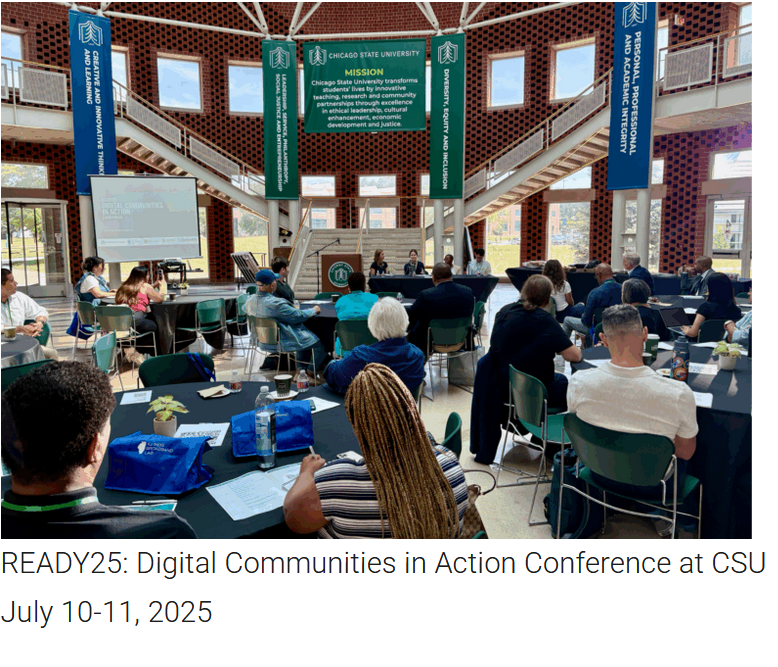 An example of this regional leadership occurred this past summer. The Northeast READY
team, led by Chicago State University and in partnership with the Illinois Broadband
Lab and financial support from Comcast, hosted the READY25: Digital Communities in Action Conference on July 10 & 11, bringing together broadband and digital inclusion leaders, digital
navigators and experts, and regional partners and stakeholders to collaborate and
learn from each other about how to increase digital access opportunities in Illinois’
northeast region.
An example of this regional leadership occurred this past summer. The Northeast READY
team, led by Chicago State University and in partnership with the Illinois Broadband
Lab and financial support from Comcast, hosted the READY25: Digital Communities in Action Conference on July 10 & 11, bringing together broadband and digital inclusion leaders, digital
navigators and experts, and regional partners and stakeholders to collaborate and
learn from each other about how to increase digital access opportunities in Illinois’
northeast region.
Over 100 attendees joined dozens of digital experts to share knowledge and inspiring stories about how to continue the work to connect all Illinoisans to high-speed internet.
Day two of the conference welcomed all families and community members from the Northeast region to come together for a day of educational resources and to engage in conversation about how to equip local communities with necessary information. Topics of discussion included keeping families safe when using the internet, creating educational opportunities, learning about financial resources and engaging in STEM, and hands-on activities for youth Pre-K–12th grade. Family households had the opportunity earn a free device by participating in at least 3 sessions of the conference, and CSU was able to distribute 19 laptops and 14 tablets, equipping 33 families with a device.
CSU will continue to host Northeast regional events in collaboration with Illinois Broadband Lab to continue these important discussions.
Looking Ahead
The ABE-LINC and Broadband READY is a model for how universities can lead the way in community connectivity. The initiatives demonstrate that bridging the digital divide requires more than just infrastructure—it demands intentional, community-rooted engagement. By placing digital navigators in neighborhoods and equipping them with the tools to teach, connect, and empower, Chicago State University and its partners have created a replicable model for digital inclusion. These programs are not just about internet access; they are about unlocking opportunity and ensuring that no one is left behind in an increasingly digital world. And as ABE-LINC’s digital navigators know, it all starts with a conversation, a helping hand, and a trusted expert willing to sit down and say, “Let me show you how.”
However, the future of these efforts remains uncertain. With the ABE-LINC grant set to expire in early 2026 and broader funding challenges looming due to federal policy shifts, sustaining this momentum will require new partnerships, continued advocacy, and long-term investment. The stories of individuals—like the 92-year-old resident who learned to use a computer or the small business owners who now actively sell online—are powerful reminders of what’s at stake. These are not just statistics; they are lives transformed by access, education, and support.
As Illinois charts its path toward a more connected and inclusive future, the work of ABE-LINC and Broadband READY offers a blueprint for success. Universities have a unique role to play in this movement—not only as centers of learning but as anchors of community resilience and innovation. The digital divide is not inevitable. With vision, collaboration, and commitment, it can be closed—one neighborhood, one household, one person at a time.

 All Rights Reserved
All Rights Reserved